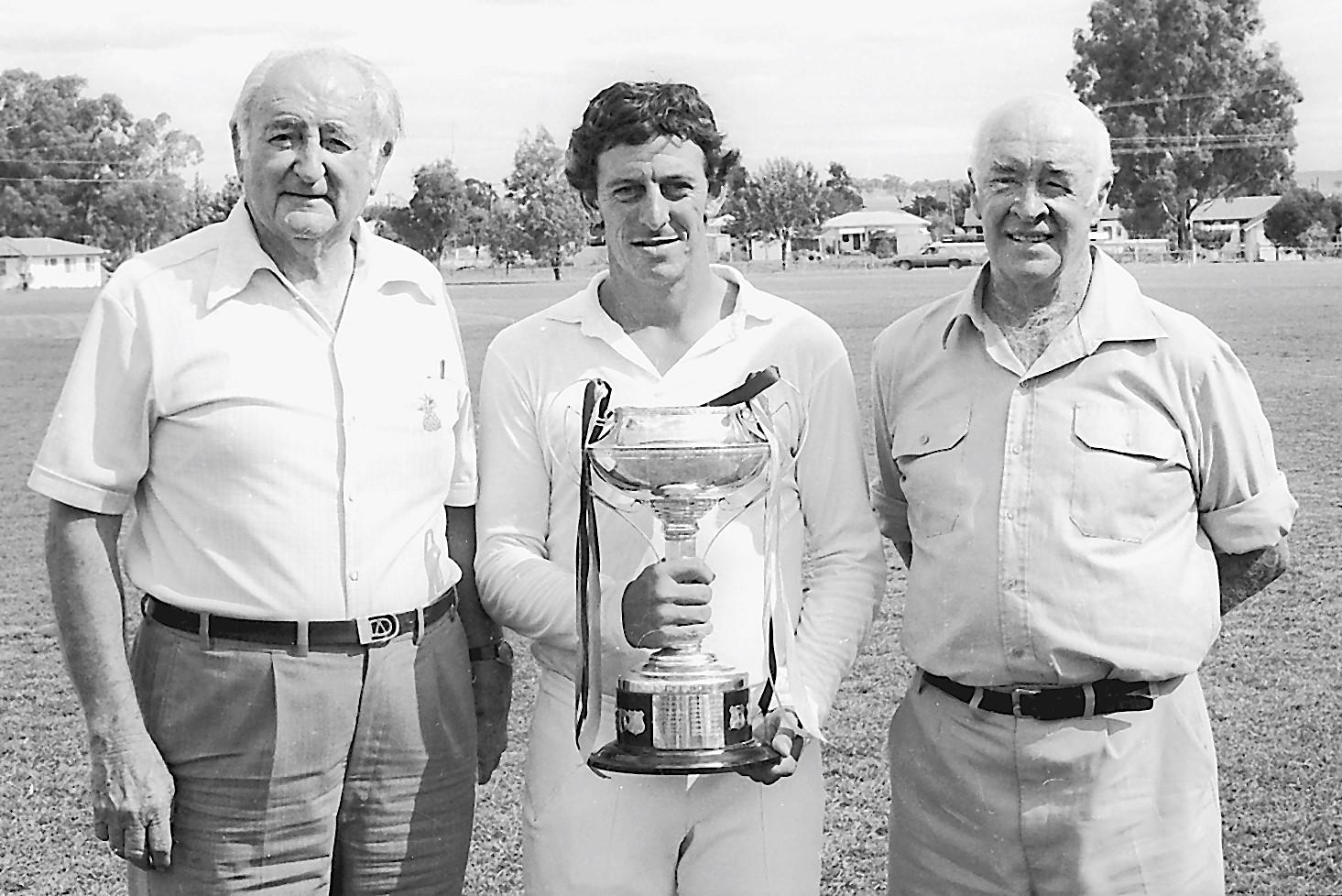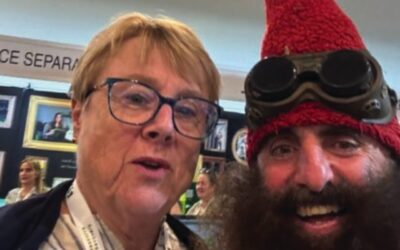The first historical record of cricket being played in the district occurred in February 1861 when a team formed by CH Lloyd, of Burburgate, challenged a combined Tamworth side in Tamworth.
The players and their supporters, 78 in all, rode on horseback to Tamworth for a fixture that was more remembered for its revelry than performances on the field.
One early scorecard records Narrabri’s win over Gunnedah in 1894 (Gunnedah 78, Narrabri 100).
In a match against combined Tamworth in February 1895, Gunnedah was routed for 38, their opponents faring little better with 64.
It was a different story in the return clash a month later, as Gunnedah (D. Cowan 80, J. King 78 and A. Bridge 53) made 234 and dismissed Tamworth for 177 (Fitzgerald four wickets, King three). According to the Gunnedah scorecard, seven batsmen failed to score.
The scorebook for the season records two matches that Gunnedah played against Sydney Tramways over Easter. Gunnedah won the first (109 and 3-55) to Tramways’ 96 and 61 but Tramways (204) beat Gunnedah (145) in the second.
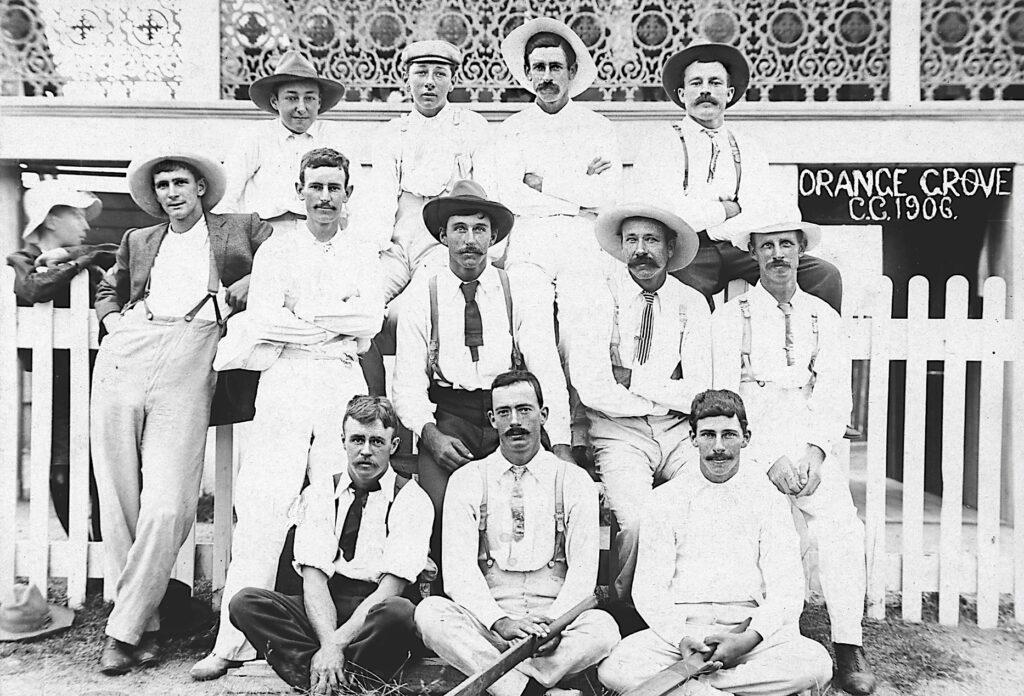
These were members of the Orange Grove Cricket Club in 1906. Back: Harry Perrett, Dave Perrett, Alf Garnham, Bill Fordham. Middle: Bert Tindall, Leister Garnham, Jim Perrett, Gus Perrett, Charles Garnham. Front: not known, Lou Perrett, Fred Perrett. Note the well-constructed white picket fence.
In April 1902 a team of parliamentary cricketers came to Gunnedah by train for a match which the local side won (Gunnedah 66 and 2-89), Parliament (76 and 17).
Cricket was largely of a challenge nature for half a century or more. Among players mentioned in early records in the 1890s were JJ Smith, TK Abbott, Arthur Jarmain, THH Goodwin, Jack Pritchard and Jack Campbell.
In the 20th century, prominent players were Sid Roberts, Dave Fitzgerald, Joe Links, Jim Brady, Bill LeCussan, Ernie Giles, Mick Connolly, Albie Thompson, Percy Scrivener, Hector Ross, Arthur Meehan, Bill McDonagh and Wick McDonnell.
In 1923 the Gunnedah District Cricket Union was formed and competition cricket quickly developed. The first president was RR Nowland, a well-known sporting name, with Cec Pritchard the first secretary.
Wolseley Park had an excellent antbed wicket for many years. It was dampened and rolled flat, setting like concrete, and on top a thick green coir mat was laid, which assisted the bowlers greatly – a spin bowler could extract wide turn and bounce and the fast bowlers could make the ball fly dangerously.
Four grounds with concrete wickets were established on the river flats. Boundary lines were marked with a single furrow plough and the wickets had to be broomed to remove horse and cow manure.
By 1934-35 the number of teams in three grades had risen to 19. The following year (1936) the first turf wicket was laid on Wolseley Park.
Among the leading lights in local cricket after World War 1 was Albert Kelly, reputed to have scored 240 in one match.
Gordon Horsfield, a State player, scored 220 in a competition final in the 1939-40 season.
Another fine player before the war was Keith Grosser, who died suddenly in his early 30s in 1946. The name, however, was carried on in illustrious fashion by his son Tim, arguably the heaviest runscorer Gunnedah has produced.
First-grade sides in the 1930s included Old Students, Milroy, Kelvin, Yarrari, Albion and Colts.
Cricket was quickly back into stride after the war and the number of teams rose to 26, including several from the district. Kelvin had a very powerful side in the late 1940s.
One of the stars of the era before the war and immediately after was fast bowler Jack Lennan, a NSW Country player, and the premier batsman of that time was Fletcher Hargrave.
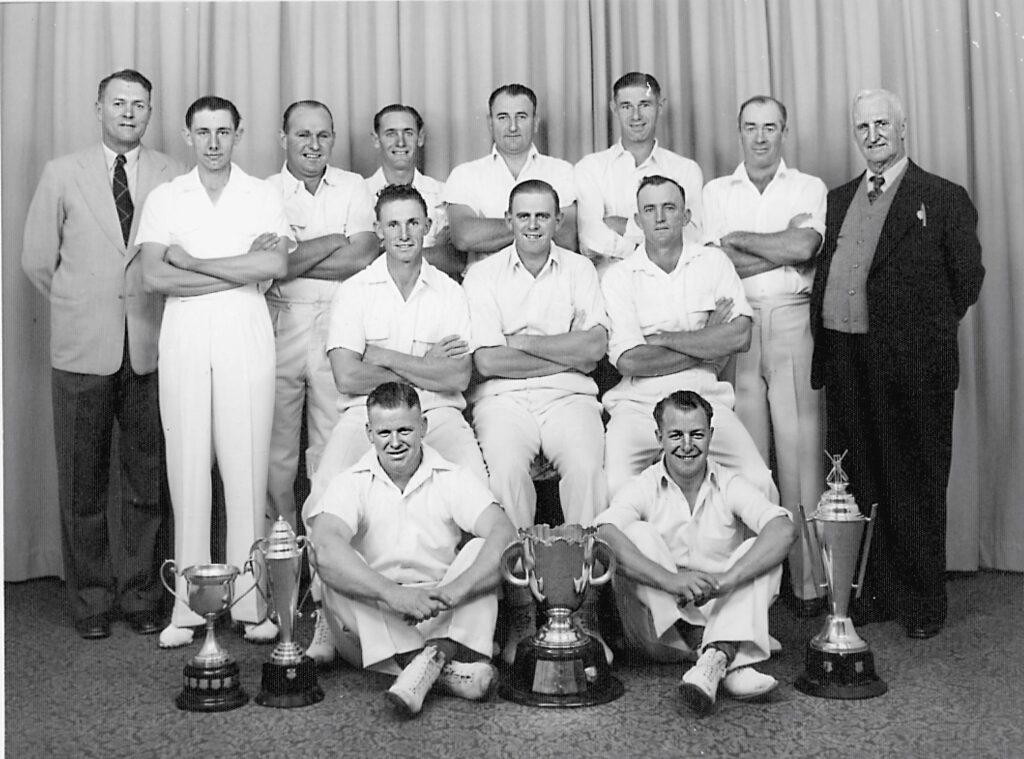
The undefeated Gunnedah First XI of 1951- 52, winning the Green-Johnston Cup, 2TM Cup, War Veterans’ Cup and Coal Board Cup. Back, left, Ken Barber (treasurer), Kevin Edwards, Ted Vaughan, John Mitchell, Frank O’Keefe, Fletcher Hargrave, Alan Ross, Mick Connolly (president). Middle, left, Kevin Beer, Roger Wotton (captain), Horrie Connolly. Seated, from left, Bill Detheridge, Keith Froome.
The golden era of Gunnedah cricket occurred in the 1950s when Roger Wotton-led teams were the champions of the north.
The era began in 1951-52 when Gunnedah swept the trophy shelf, winning the Green-Johnston Cup, 2TM Cup, War Veterans’ North and North West Championship Cup and the Coal Board Cup.
The team included topline batsmen Fletcher Hargrave, Ted Vaughan, Keith Froome, who had been a rugby league international, Roger Wotton, Frank O’Keefe, Alan Ross, Kevin Edwards, Kevin Beer and Bill Detheridge.
Although there were personnel changes, with several outstanding younger players coming into the side, the domination continued into the 1960s, when players such as Tim Grosser and Phinny Herden came into their own.
Alan Ross was an express bowler and punishing batsman, the son of Hector Ross, one of Gunnedah’s best-known sportsmen, who excelled in cricket, golf and bowls.
Alan Ross played for North West at Country Week before the war and was the front-line bowler in the Gunnedah team which dominated after the war when Jack Chegwyn brought a team to Gunnedah in 1950. Test fast bowler Ray Lindwall rated Alan Ross the fastest bowler in any of the teams they had encountered on their country tours.
Frank O’Keefe, a spin bowler and determined batsman, was a key figure in the champion team in the 1950s. In an interview in 1979, he rated Alan Ross very highly (‘best fast bowler I ever saw in the bush’) and Roger Wotton the best captain (‘he never lost control of a game and he pulled the right rein every time’). Fletcher Hargrave and
Keith Froome were ‘beautiful batsmen’ and Tim Grosser (‘a devastating batsman… could tear an attack apart’.)
Phinny Herden and Tim Grosser established scoring records that may stand for all time in the 1962-63 season. Grosser, then a 20-year-old, scored double centuries in the semi-final and final of the North West intertown competition and Herden a double century in the final.
Against Tamworth Blue in the first match, Gunnedah rattled up 479 runs for the loss of six wickets at Wolseley Park with Grosser hammering 225 in 240 minutes. In the final a fortnight later against Tamworth Red, opener Herden made 202 in 225 minutes and Grosser 229 in Gunnedah’s massive tally of 4-511. Herden and Grosser shared a stand of 298 in three hours, a record that has never been challenged.
In a four-week period that season, Grosser scored 816 runs – the two double centuries against Tamworth teams, a century against Cessnock in a Coal Board Cup fixture and a century for Milroy in the local competition.
Grosser joined the Balmain club in Sydney in the 1964-65 season, travelling down by train on Friday nights and returning the next day, usually for a representative fixture.
He was one of the most successful batsmen in Sydney grade, setting a Balmain club record of more than 700 runs in 1968-69.
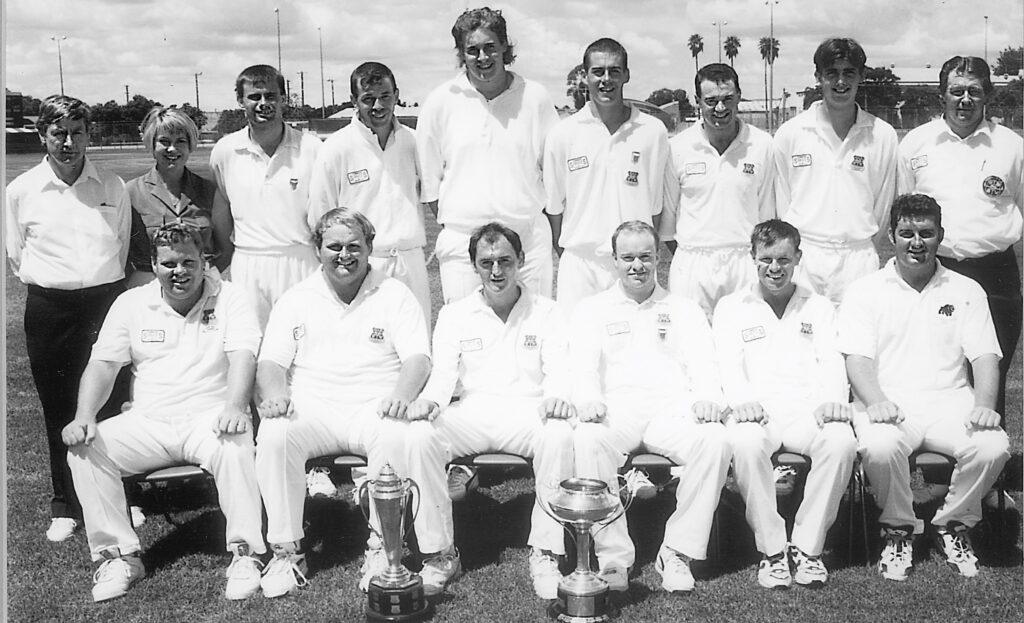
The Gunnedah team which won the Triple Crown (Nowland Cup, War Veterans’ Cup, 2TM Cup) in 1997-98. Back, from left, Kevin Miller (umpire), Judy Middlebrook (scorer), Ian Creer, Paul Foster, Ben Ryman, Jamie Lucas, Wayne McDonald, Ben Middlebrook, Kevin Wicks (umpire). Front, from left, Barry Turner, Paul Herden, David Marshall, Adam Hockley, Grant McIlveen, Andrew Keeler (12th man).
The following season he was selected for two games for NSW in the Sheffield Shield. In the second game, he scored 48 in the first innings against Western Australia and was on 20 in the second when he was struck on the head by pace bowler Lawrie Mayne and taken to hospital. He lost his place for the next game, with many of his supporters claiming that his aggressive attitude to batting, and the conservatism of the selectors, led to his axing. During his outstanding career, Grosser also played for NSW Colts and, on four occasions, for NSW Country.
Another exceptional cricketer was Michael Hussey, a right-arm fast bowler and explosive batsman. Hussey produced whirlwind knocks in club and representative cricket, none more so than his 104 not out in 65 minutes at Wolseley Park for Gunnedah against the touring New Zealand Canterbury Colts, a team which included later fast-bowling great, Richard Hadlee. On that day, Hussey (five sixes and 10 fours) shared an unbeaten stand of 150 with Len Koch (45).
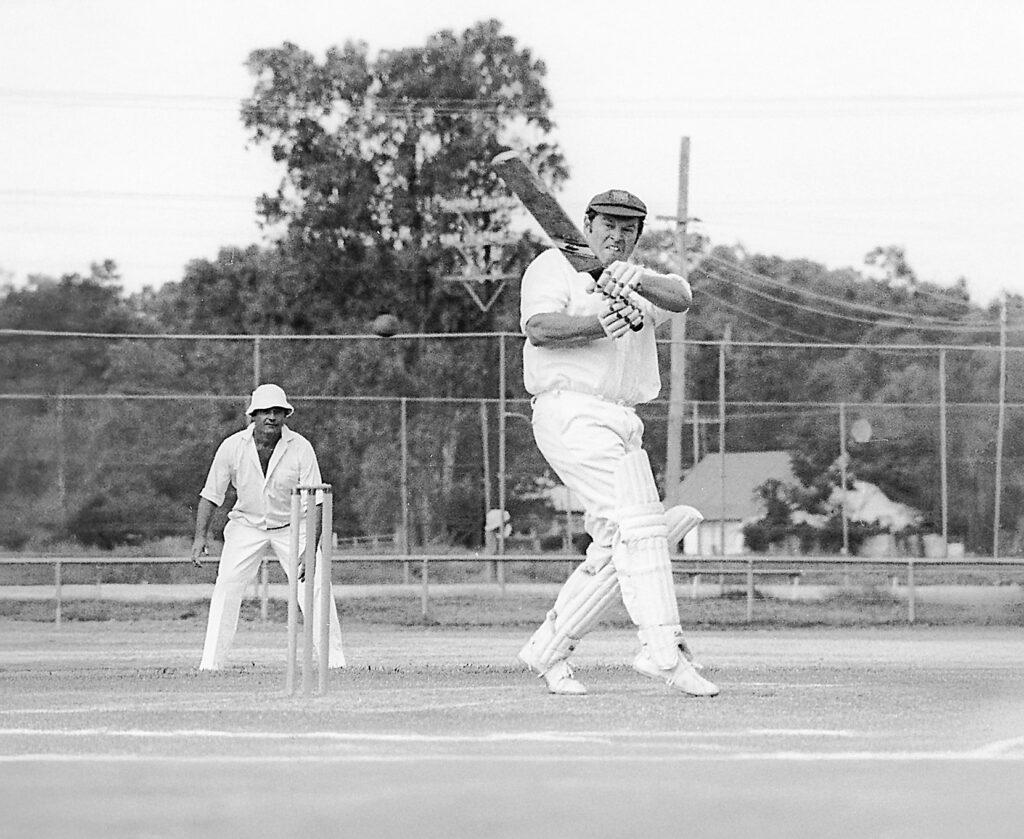
Tim Grosser on the run rampage at Wolseley Park. He was the heaviest rungetter local cricket has ever seen.
In the 1986-87 season, Gunnedah became the champion team of the north for the first time in 30 years, downing Manilla in the grand final of the Nowland Cup (North West) and then wresting the War Veterans’ Cup from Armidale. Gunnedah’s tilt at the War Veterans’ Cup was spearheaded by captain Mike Brady, who made 95 as Gunnedah reached 221. With Sam Lyle claiming 4-25 from 12 overs, Gunnedah then dismissed Armidale for 129 …. and that’s just a little of the history of ‘the summer game’ in Gunnedah.
The Tamworth Examiner newspaper recorded the first district game with Gunnedah, which took place on February 13 and 14, 1861. It was a challenge match between a Gunnedah side formed by CH Lloyd, part-owner of Burburgate Station, and a combined Tamworth side.
The Gunnedah team and its supporters, 78 in all, rode to Tamworth on horse-back. It rained most of the way and they had to cross swollen creeks.
Their arrival in Tamworth caused great consternation. The newspaper reported that the women of Tamworth hustled their children indoors and closed the doors, fearful that the horsemen were bushrangers.
Play did not start until 3pm because of the rain and the wet wicket and was interrupted during the afternoon. At night there was a dinner and celebrations which continued until the early hours of the morning.
Wickets tumbled the next day on the soft wicket, Tamworth winning by five wickets. Gunnedah made 35 in the first innings and 59 in the second and Tamworth made 44 and 5-52.
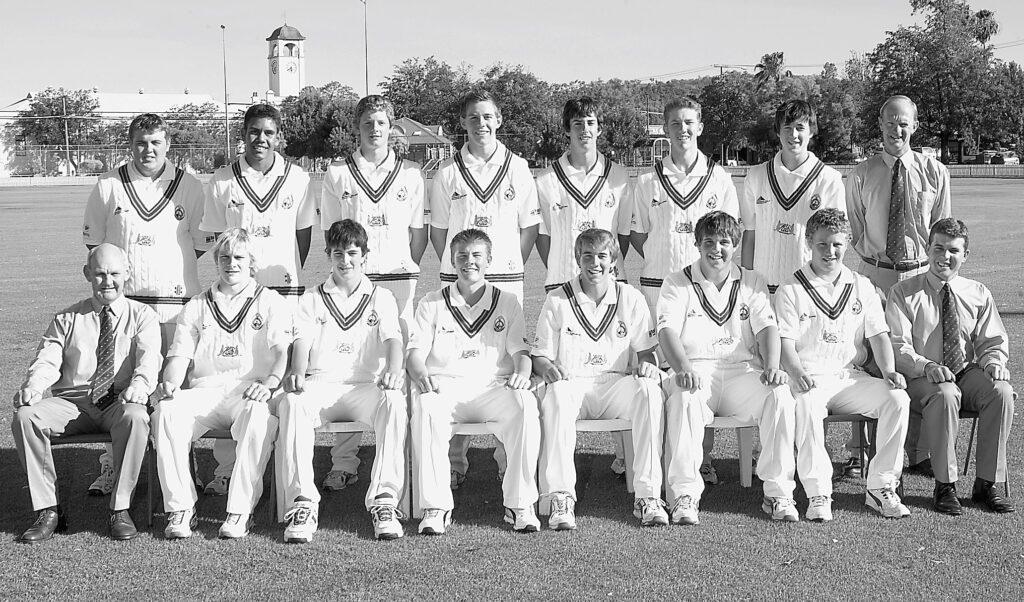
The Gunnedah Schoolboys cricket team, the Kangaroos, made a 16-day tour of New Zealand in January 2006, having toured Malaysia in 1998. Back row, from left, Sam Doubleday, Farran Lamb, Reece Jaeger, Trent Hilton, Kyle Gallen, Greg Gallen, James Wilkinson, Kel Walls (coach). Front, from left, Mike Silver (chef de mission), Robert Jones, Jordy Ford, Josh Scaysbrook (captain), James Mack, Andy Mack, Cameron Amos and Adam Marshall (manager).
